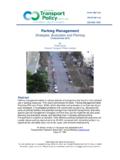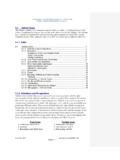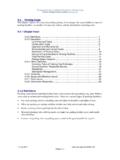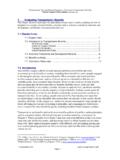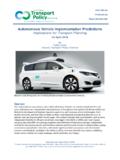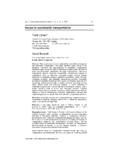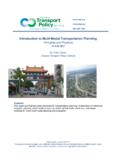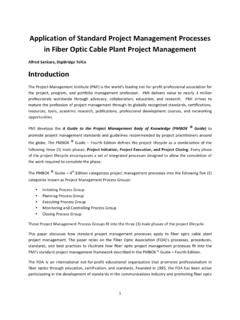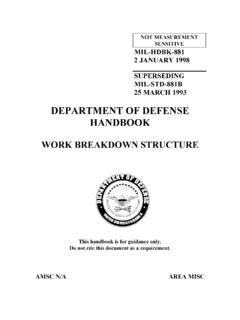Transcription of Whats It Worth - vtpi.org
1 250-360-1560 Todd Alexander Litman 2001-2006 You are welcome and encouraged to copy, distribute, share and excerpt this document and its ideas, provided the author is given attribution. Please send your corrections, comments and suggestions for improving it. what S IT Worth ? Economic Evaluation For Transportation Decision-Making 16 July 2006 Todd Litman Victoria Transport Policy Institute Originally presented at the Internet Symposium on Benefit-Cost Analysis Transportation Association Of Canada ( ) February 2001 Abstract This paper discussed the application of economic analysis techniques to transportation planning and management. It describes specific techniques including Cost-Effectiveness, Benefit-Cost Analysis, Lifecycle Cost Analysis, and Multiple Accounts Analysis. It discusses common problems associated with economic analysis techniques used in transportation decision-making, particularly when comparing investments in alternative modes or evaluating Transportation Demand Management options.
2 This paper describes specific solutions to these problems, and provides recommendations for producing analysis that is accurate and useful. It discusses specific factors that should be considered when evaluating transportation policies and programs. what s It Worth ? 1 It is unwise to pay too much, but it is worse to pay too little. When you pay too little, you sometimes lose everything because the thing you bought was incapable of doing the thing you bought it to do. John Ruskin (1819-1900) Context This section describes the context for performing economic analysis. Economic evaluation (also called economic analysis or appraisal) refers to methods for determining the value of a policy, project or program. It is an important component of planning and management. Other important components include information collection and distribution, a decision-making process, public involvement, institution development, and negotiation between stakeholders.
3 We frequently perform economic evaluation. Virtually any consumer, business or public policy decision involves some sort of economic analysis. For minor decisions it may be sufficient to perform such analysis in your head or to use standard guidelines, but when making major decisions it is helpful to follow a more explicit and comprehensive process to insure that all significant impacts (costs, benefits and equity effects) are considered. Economic evaluation can be performed well, or it can be performed badly. Transportation decisions are frequently criticized for inadequate and biased economic analysis. This paper describes techniques for performing comprehensive and objective evaluation, and identifies ways to avoid common problems. what s It Worth ? 2 Planning and Evaluation Techniques This section describes planning and evaluation techniques, and discusses how different perspectives, goals and measurement units can affect analysis outcomes.
4 For more information see Litman, 2006. The Planning Process It is helpful to begin any planning process with a vision, goal or problem statement (these are essentially the same thing from different perspectives). Goals describe what you ultimately want to achieve, but are often difficult to measure. The next step is to establish specific, achievable objectives, with suitable evaluation criteria. For example, if the goal is to improve access, objectives may include a particular reduction in traffic congestion delay, an increase in transit trip speeds, or a reduction in barriers to non-motorized travel. Evaluation criteria can include quantitative factors such as cost per unit of output ( , dollars per additional passenger trip), and qualitative factors such as public acceptance. It is usually best to select several objectives that range from general ( , improve travel choices for non-drivers) to specific ( , a 50% reduction in potholes within two years).
5 Once objectives and evaluation criteria are established, policies, programs, projects and tasks can be selected. A policy is a general course of action. A program is a coordinated effort with specified resources (funding, staff, etc.) and responsibilities. A project is a program with a specific deadline. A task is a specific mission or activity. Each of these should incorporate evaluation criteria. It is useful to start collecting baseline data before projects are implemented. Box 1 illustrates steps in a planning process. Of course, this is an idealized outline that often must be adjusted to account for particular circumstances. Box 1 Steps in a Planning Process Vision, Problem, or Goal Statement (examples: Safety, health, mobility, equity, economic development) Objectives (examples: Teach safety, improve roadway and trail facilities, increase non-motorized travel) Evaluation Criteria (examples: Accident/injury rates, Bicycle Compatibility Index, non-motorized travel rate) Policies, Programs, Projects and Tasks (examples: Adopt design standards, establish new funding, implement road and trail projects) Program Evaluation (examples: Are objectives achieved?)
6 what are overall benefits and costs? Do clients like it?) Creating an Evaluation Framework An evaluation framework specifies the basic structure of the analysis for clear and consistent evaluation and comparison. A framework usually identifies: Evaluation method, such as cost-effectiveness, benefit-cost, lifecycle cost analysis, etc. Evaluation criteria are the factors and impacts considered in a particular analysis. Impacts can be defined in terms of objectives or their opposite, problems (for example, congestion what s It Worth ? 3 reduction is an objective because congestion is considered a problem), or they can be defined in terms of costs and benefits (for example, congestion reduction benefits can be measured based on reductions in congestion costs). Planners tend to use the terms objectives and problems (which are more qualitative), while economists tend to use the terms benefits and costs (which are more quantitative), all of which can be considered different approaches for evaluating the same impacts, as illustrated below.
7 Table 1 Ways to Describe An Impact Positive Negative Qualitative Objective Problem Quantitative Benefit Cost Objective, Problem, Benefit and Cost are different ways to describe an impact. Modeling techniques, which predict how a policy change or program will affect travel behavior and land use patterns, and measure the incremental benefits and costs that result. A Base Case (also called do nothing), the conditions that would occur without the proposed policy or program. Reference units, such as costs per lane-mile, vehicle-mile, passenger-mile, incremental peak-period trip, etc. Base year and discount rate, which indicate how costs are adjusted to reflect the time value of money.
8 Perspective and scope, such as the geographic range of impacts to consider. Dealing with uncertainty, such as whether sensitivity analysis or statistical tests will be used. How results are presented, so that the results of different evaluations are easy to compare. what s It Worth ? 4 Measuring Transportation How transportation activities are measured can affect the evaluation process. There are three common ways to measure transport, representing different perspectives and assumptions (VTPI, 2006, Measuring Transportation ): 1. Traffic refers to vehicle movement. It is measured using vehicle-miles and vehicle-trips, roadway Level-of-Service (LOS), average traffic speeds, vehicle delay, and vehicle operating costs. It assumes that transport improvements consist of vehicle travel.
9 It is the easiest way to measure transportation and is commonly used in transport planning. 2. Mobility refers to the movement of people and goods. It is measured using person-miles, person-trips and ton-miles, average trip speeds, and cost per person- or ton-mile. It recognizes automobile, transit, ridesharing, and to a lesser degree, non-motorized improvements to transportation problems. It is moderately difficult to measure. 3. Accessibility refers to the ability to reach desired goods, services and activities. It is the ultimate goal of most transport (except the small portion of travel with no destination). It is measured using generalized cost (money, time and discomfort) per trip. Accessibility is relatively difficult to measure and so is not often used in transport planning. Which is used can affect analysis conclusions.
10 Consider school transport, for example. Analysis based on traffic assumes that transportation is improved by accommodating more vehicle traffic and parking. From this perspective, the best school location is on a major arterial with abundant parking. Analysis based on mobility also values transit, ridesharing and cycling. From this perspective, the best location is on a busy arterial with transit service and bikelanes. Analysis based on access allows both mobility and land use strategies to be considered. From this perspective the best location may be in the middle of a neighborhood, where walking and cycling are convenient, although automobile access and parking may be limited. These objectives may conflict: traffic improvements may result in solutions that degrade other forms of mobility and access. Accuracy Versus Precision Anybody involved in economic analysis should understand the difference between accuracy and precision.
